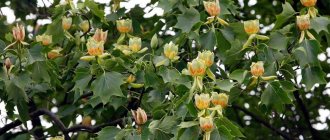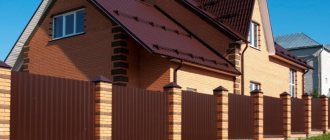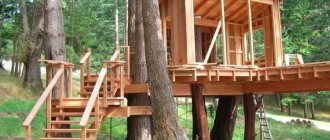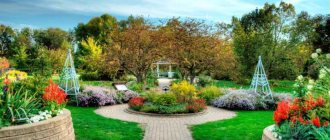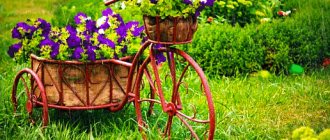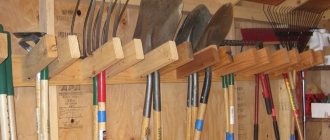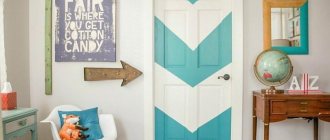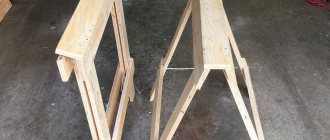Country style (country) involves creating a garden in a rural spirit. And annual and biennial plants are ideal for this role. Here are some tips on how you can combine the main elements of a country style garden.
To make such a flower garden at your summer cottage with your own hands, you need:
- imitate natural lawns using wild plants;
- combine flower and fruit crops into one composition;
- use handmade products and figurines made of wood, stone or clay in the form of birds, domestic animals and mythological creatures;
- place birdhouses and bird feeders, wooden benches, fences and fences, as well as rustic pots and cast iron pots.
Of the flower crops, preference should be given to summer flowers, because they are not picky, look natural and familiar, as if they grew up in the garden themselves. The color scheme of country style should be dominated by bright and expressive shades: white, light green, yellow, red, orange, pink, purple, etc.
Planning
Modern design of the site involves careful planning of green areas. At this stage, you will have to think about the location and layout of the pets, arrange suitable living conditions for them (hide shade lovers away from the sun's rays, install trellises for climbing plants, install fences that limit growth).
The green site improvement project involves dividing the site into three parts:
- the first (external) part will beautifully design the boundaries of the land plot;
- the second (internal) will allow you to design the territory adjacent to the house;
- the third (middle) will help fill the rest of the area free from beds.
There are no special rules for landscaping, so each housewife chooses for herself the most attractive solutions from her point of view. But the landscape design of the site in any case should be one whole.
Peculiarities
In order to properly improve a personal plot, the homeowner must create a full-fledged artistic composition on it. In this case, it is necessary to take into account not only the stylistic directions of the territory design, but also to determine priorities. For example, if a house is used for permanent residence and recreation, then the landscape design mainly consists of lawns and perennial plants. If you plan to grow vegetables and fruits here, then a special role should be given to beds and fruit-bearing trees. To create a decorative garden, flowers and other elements are used, for example, an artificial reservoir (fountain, pond or pool).
The key feature of independent landscape design of a personal plot is that there should be enough space around the house not only for a pond and beds, flower beds and trees, but also for larger decorative elements and additional buildings. In this regard, you need to start with a layout that allows you to avoid mistakes in designing the site yourself. It is important to create a unified and logical composition, combining architecture and plants, texture, shapes and colors. The combination should be bright and contrasting, but at the same time harmonious.
You can add volume to your garden plot with the help of tree crowns and lush shrubs, but flower beds and lawns serve as flat elements. In addition, it is important to correctly correlate the shape and size of all design elements of the estate; for example, if flower beds and shrubs have rounded shapes, then sharp-angled decorative elements will be inappropriate here. Also, when designing a backyard area, it is important to highlight the central element from which you need to build. This item should focus attention on itself, acting as a key decorative item (a gazebo, a pond or a large colorful flower bed).
When creating a landscape design, special attention should be paid to color combinations, because an area that is too colorful will seem tasteless. To decorate your local area, it is important to choose several primary colors, diluting them with similar shades. When choosing a color scheme, you need to remember that it can change, since many plants quickly fade and you need to remember the time (period) of their flowering.
Site boundary
The outside of the property is usually bordered with a boring fence, but you can try a little and create an unusual green border. A hedge will help create a pleasant fence that will reliably protect you from the dust and noise of the street and the prying eyes of passers-by or neighbors.
Usually, fast-growing vines are chosen as a green barrier, which in a couple of seasons will weave throughout the entire space allocated to them. The most common unpretentious ones:
- wild grapes:
- castor bean;
- lemongrass;
- evergreen ivy.
For experienced gardeners, it is not difficult to complement the green wall with climbing roses or clematis.
Shrubs would be a good fence, but such a fence will not protect the area from indiscreet eyes and dust. For a fence near the road choose:
- cotoneaster;
- juniper bushes;
- lilac;
- mock orange
Fruit bushes will mark the internal border for the benefit of the owners.
If the terrain is difficult
A perfectly flat site is very rare. It takes a lot of effort to create one. Uproot the stumps, level the surface, create it in two levels, if necessary.
Before planting plants, you need to fertilize the soil or create fertile soil. The landscape design of a small area should not contain symmetry and straight lines.
In addition, the symmetrical arrangement of objects and details creates a monotony effect, which quickly tires. Asymmetry makes the courtyard composition more dynamic and natural.
There should be few paths, only the most necessary ones need to be done. In a small area, irregularly shaped paths, like paths in nature, will look better.
We recommend reading:
The best options for site planning: modern ideas, the best solutions and beautiful arrangement and design schemes (125 photos + video)- How to make drainage on a site: device, types, design and camouflage (110 photo ideas)
Do-it-yourself sliding gates: projects, designs, drawings, photos and video description of the construction (135 photos)
The fence acting as a fence should not be massive. It is advisable to decorate it with vines, hops or other vines, which will visually create the appearance of a continuation of the site.
The area in front of the house
The landscaping of the area in front of the house depends on the chosen style. Most often found here:
- bright or formal front gardens;
- separate flower beds;
- potted flower beds;
- fluffy borders;
- arches and pergolas entwined with plants.
The latter option is perfect for masking the flaws of builders and the influence of the inexorable passage of time. It will also help you create lovely relaxation areas with a garden swing or cozy nooks for drinking tea.
Flower Creek
Such an unusual flower bed is an excellent design solution for a rustic-style garden. Place a large clay pot or jug in the middle of the lawn, laying it on its side and firmly anchored in the soil. Mark the proposed “bed”, remove the turf in that place and add garden soil. Plant marigolds, ageratum, alyssum, compact petunias, forget-me-nots, lobelia, verbena, low carnations and other flowering plants there.
- Flower stream is a great idea for a fun garden
Detailed instructions for creating a flower stream.
Rest of territory
Beautiful landscaping of the entire remaining territory will make the area cozy and fresh. For this use:
- flower beds;
- lawns;
- topiary;
- fruit or ornamental bushes and trees.
The area for landscaping will need to be first leveled or, conversely, raised depending on the design options, fertilizers must be applied, and an irrigation system must be provided. All elements can be used individually or create a beautiful ensemble united by one idea.
Flowerbeds
No garden design is complete without flower beds. They can be:
- Strictly regular, when all their inhabitants bloom at the same time and fade away just as quickly. Such flower beds are characterized by clear lines and monochrome.
- Carefree, irregular, filled with plants of the most diverse flowering dates and colors. Most of all, such flower beds are designed to imitate natural corners left to their own devices.
- Elevated when the plants are located at some distance from the ground. It is easier to care for such flower beds, but only annuals can be planted here: in a frosty winter, the roots of perennials can die from the cold.
- Vertical, filling trees, walls, trellises, arches, stairs, racks.
- Potted, represented by flowers in pots, buckets and pots. Such flower beds can easily be moved to another place and replenished with new inhabitants to replace faded plants.
According to their shape, flower beds are divided into:
- classic (round, oval, square, rectangular, diamond-shaped and trapezoidal);
- arabesques laid out in the shape of a flower, animal, bird;
- borders, mixborders and ridges located along paths, near houses, fences, boundaries of functional zones;
- rock gardens and rockeries.
Beauty by the windows
Flower plants should be planted near the house. They will create some kind of noise protection and provide the opportunity to admire the created beauty from the window of your home.
The design of a small garden involves smoothing straight lines and corners with plantings. An alpine hill or rock garden will decorate any area, and in a small area it will claim to be the dominant feature.
The beauty of plants combined with stones will create a small copy of a natural mountain. Near an alpine hill or flowerbed, a small pond made from a shape reminiscent of the natural contours of a lake will look beautiful.
The shore of the reservoir will be decorated with pebbles, shells and plants. Pots with petunia or lobelia will look beautiful, with their hanging garlands fabulously decorating any facade of the house.
Large flowerpots placed in the most prominent places will look beautiful.
Lawns
Cozy green meadows are increasingly decorating the summer cottages of even avid gardeners. Usually they are located in the entrance area, so as not to spend a lot of time maintaining a cozy appearance of the territory, or in the recreation area, where they are intended for playing with children or carefree lying in the sun.
According to their intended purpose, lawns can be:
- decorative, intended exclusively for admiring fluffy grass;
- practical, withstanding occasional walking on green surfaces.
According to the installation method, they are distinguished:
- sowing;
- rolled lawns.
Topiary
The ancient Japanese art of curly pruning of trees and bushes is rarely used in Russian dachas. Firstly, this is quite labor-intensive work, which many people simply don’t get around to, and secondly, tree figures require larger spaces than the usual 6 or 9 acres.
Most often, Russian topiary involves trimming border bushes.
A good option for such landscaping would be to fill a ready-made frame with plants. It does not require complex care or design skills.
Garden plot design: landscaping and decor
The most interesting and difficult stage of designing a personal plot is landscaping. It is best to start with colors, which you need to choose based on their characteristics. Landscaping includes:
- Herbaceous plantings.
- Fruit and ornamental shrubs.
- Fruit and ornamental trees.
- Lawns.
- Flowerbeds and flowers.
When choosing flowers, it is important to determine the duration of their flowering and seasonality, wisely combining plants with each other. In the optimal case, you can create a flower bed that blooms from early spring until frost. It is better to place trees away from flowers, as they can shade them, causing them to dry out and turn yellow. The distance between the trees is 1.5 meters, the location is on the north or west side of the plot. When planting, it is important to observe symmetry and the rule of repetition.
An interesting element of landscaping is a hedge made of coniferous or evergreen plants. It is important to remember that such a hedge requires constant care to allow it to maintain the desired shape and size. It is better to choose a universal type of lawn so that it does not require special care. As for flower beds, the following types of design are distinguished:
- Mixborder.
- Border.
- Rabatka.
- Arabesque.
- Floating flower beds.
- Ribbon flower beds, etc.
As for the decor, paths and paths made of unusual materials, such as stones and shells, ceramic tiles and wild stones, are used as decoration. Another decorative element is reservoirs, the role of which is played by fountains and cascading waterfalls, ponds and streams. A water mill can add elegance to a pond, which you can equip on your own. You can supplement the pond with aquatic plants and fish by lining the pond with pebbles around the edges, and connecting the banks with a small wooden bridge. Also used as decoration are: cobblestones, alpine slides and rock gardens, improvised means and figurines, small architectural structures (outdoor kitchens and stoves, gazebos and swings).
Trees and bushes
As photos of the landscaping of the site show, these two elements are certainly present on the dacha plot. Practical housewives choose the same practical fruit plantings for themselves, while others prefer to plant less useful, but more original thujas, pine trees, spruce trees, lilacs, and junipers.
Green spaces add beauty and bright colors to the site, helping to create real masterpieces or simple compositions that comfortably fill the air with oxygen, delicate aromas, and the buzz of bees and bumblebees.
Therefore, there is no need to be afraid to create: any flowerbed or bush will return a hundredfold all the energy spent on it.
